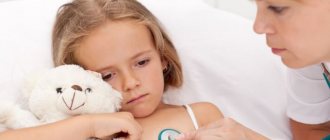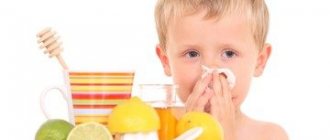Timely prevention of ARVI in children will help avoid, if not the disease itself, then significantly alleviate its course. Viruses love cold and damp environments, which occur mainly in spring and autumn. But even in winter, when solar activity is low and people lack vitamins (mainly C and D), the immune system does not cope well with influenza viruses and pathogens of acute respiratory infections. Old people and children are especially susceptible to respiratory tract damage. But if older people themselves are able to take care of their health, then the health of children falls entirely on the shoulders of their parents. What needs to be done to reduce the risk of contracting off-season ARVI and not have to sit on sick leave with your child?
Why do children get sick more often?
In autumn and winter, when it is cold and humid outside, and the house is hot and dry due to working heating radiators, a sharp change in temperature and humidity has a very negative effect on the nasopharyngeal mucosa. The dry air of apartments dries it out, and it becomes vulnerable to viral attacks in the humid air of the streets and the person becomes infected. With children, due to the immaturity of their bodies, this happens much more often than with adults.
In spring, the deceptive warmth of the still inactive sun poses another threat. Tired of warm clothes, people want to take them off as quickly as possible, but in the meantime, viruses are not sleeping! As soon as a boy, steamed from the heat of the sun, takes off his “biting” hat, they (viruses) begin to attack his immunity, which, most often, during this period is weakened by vitamin deficiency.
The children's immune system, which itself is not yet fully formed, experiences greater stress when its usual conditions change and therefore rebuilds much more slowly than in adults. Children get colds more often than adults, and not only in the off-season or winter, but also in the summer. Therefore, prevention of influenza and ARVI in children should be carried out before going to kindergarten or school after the summer holidays, and before going on vacation to the sea or going to a summer holiday camp.
Prevention of influenza in children
- Frequent walks outside occupy an important place in preventive measures. They strengthen the baby's body. It is important not to visit places where many people gather and smoky areas.
- Take care of the daily ventilation of the room in which the little one lives.
- Teach your baby to personal hygiene. Let him remember to wash his face, wash his hands, don’t drink from someone else’s cup, and don’t use someone else’s towel.
- Carry out a wet frill, the more often the better.
- During the flu season, it is advisable to always have chopped garlic and onions at home - these are natural phytoncides, they will build a barrier against the virus.
- If there are people with the flu in the family, exclude the child from contact with the infected person. Have the sick person in a separate room. If this is not possible, use a gauze bandage that will prevent the transmission of viruses by airborne droplets, just remember to change it every two to three hours.
- One of the best ways to prevent it is to get vaccinated against influenza.
Flu shot
You will find many supporters of vaccination and no less opponents. It's up to you to decide, but such a vaccination helps protect the baby from infection or helps make the course of the disease easier. In addition, the latest generation of vaccinations is practically incapable of causing consequences in children.
It is recommended to vaccinate people who are at risk, namely:
- If you have diabetes.
- Metabolic disorder.
- Infants, starting from six months.
- Children with pathologies of the respiratory, cardiovascular and excretory systems.
- Toddlers who are in a team have constant communication with a large group of people.
- Children diagnosed with immunodeficiency.
- Carriers of staphylococcal infection.
But you should not forget about possible reactions to the vaccine:
- Slight increase in body temperature.
- Redness of the injection site.
- Slight tightening of the injection area.
- Headache.
- Weakness, drowsiness.
You can read about possible complications that occur in isolated cases in the article “Flu vaccination for children: should it be done or not.”
Signs of an impending illness
How do children become infected with influenza and acute respiratory viral infections?
- Entering the epithelial cells through the mucous membrane of the nasopharynx, that is, into an environment favorable for its reproduction, the virus begins to actively break through the protection of the immune barrier.
- Through the blood, harmful and highly active pathogens spread throughout the body and settle in the cells of various parts of the body.
- Their active vital activity is converted into toxins that affect various organs and cause a number of severe symptoms.
- It all starts with nasal congestion and a sore throat, followed by fever and severe headaches, as well as chills and aching joints. Difficulty breathing, shortness of breath, muscle pain and constant drowsiness complement the symptoms.
It must be said that the very concept of ARVI does not specifically imply any one disease, but refers to various viral infections, including influenza. Therefore, it is very important in the initial stages to identify the true source (virus) that led to the disease, and then begin treatment. Only a doctor should do this, and therefore you should not start treating the child yourself. It is necessary to consult a specialist who will prescribe the medications necessary for a particular infection. After all, an error in treatment can easily lead to complications and even irreversible consequences in the body.
Medicines for preventive purposes
To prevent ARVI, the following drugs may be prescribed:
- Tamiflu. The tablets are taken for up to two months.
- Relenza. An inhaler that reduces the susceptibility of the respiratory tract to the virus.
Means for preventing influenza:
- Arbidol. Take it for at least two weeks.
- Agri.
- Kagocel. Increases the production of interferon in the baby's body.
- Anaferon and Aflubin are homeopathic preparations that increase immunity.
In addition, drops can be prescribed for the prevention of viral diseases: Grippferon, Derinat and Ingaron, as well as ointments: Oxolinic and Fleming ointment.
How to protect your child from ARVI
Let's start the conversation with myths that prevent parents from correctly assessing situations in which a child may become infected with ARVI.
- There is an opinion that if a child does not come into contact with a sick person, then he himself will not become infected. But in fact, it may well become infected not from people, but from objects. Even from the elevator call button in the entrance or from the handrail on the seat on the bus. After all, the pathogens of the disease remain viable in a room from several hours to several days, especially if this room is also poorly ventilated. And as soon as the baby touches the railing, which the patient touched not so long ago, and then puts his finger in his mouth or scratches his eye, the virus is right there.
- Some people think that there is no need to be afraid of a person if he does not have a fever. Many parents ignore the fact of illness if the child does not have a fever and boldly take him to kindergarten. But the absence of temperature at the initial stage of the disease does not indicate the absence of the virus inside the body. The baby is already a carrier of the infection. In addition to temperature, other symptoms, which have already been discussed in the article, indicate health status. Thus, healthy children become infected from a sick child only because his mother thought that he could attend kindergarten due to the lack of fever.
- If a child has recently had the flu, then he will not get sick with ARVI any time soon because of the immunity he has developed. Do not forget that acute respiratory infections are not only the flu (which also has many different strains), but also many other viral diseases. Therefore, a child, especially one with a weakened immune system after an illness, can easily get sick again.
Taking into account all these nuances, it is necessary to carry out prevention of ARVI in children every two to three months and take measures to reduce the risk of getting sick.
What is included in preventive measures
The following preventive measures are used in kindergartens and schools, but they are also necessary at home.
- A child needs a clear daily routine that excludes physical overload and fatigue and includes a healthy and full night’s sleep of up to 8 hours a day (and for children, also daytime rest) and walks.
- During walks, children should avoid hypothermia or overheating, so they should be dressed according to the weather, but taking into account their activity, so that they do not sweat in warm clothes.
- The room (apartment, children's room) should be ventilated regularly, at least 3-4 times a day for 10-20 minutes, especially during the heating season. It is also important to regularly wet clean the apartment, avoid drafts and monitor the temperature (not higher than 23℃) and humidity (not less than 50) in the bedroom.
- From a very young age, a child needs to instill the habit of washing his face in the morning, after a walk and before bed, washing his hands more often (after using the toilet, before eating, after playing) and hardening himself, that is, taking a cool shower, walking barefoot on the ground and heated floors in the summer.
- Provide your baby with a towel separate from adults and teach him to use a handkerchief when he has a runny nose or cough.
- During the epidemic, limit trips to cafes, cinemas, clubs, and other crowded places. If possible, do not take your child to kindergarten, but transfer the student to distance learning.
- Monitor your child’s diet and feed him only fresh foods rich in minerals, vitamins and antioxidants: dairy and fermented milk products, berries, fruits and vegetables, fish, chicken, cereals. Eliminate fatty, fried foods, snacks and fast foods, limit your consumption of sweets.
- If you decide to supplement your child’s diet with vitamins C and D, ascorbic acid or nutritional supplements, and also give him a drug to prevent ARVI, then first consult with your pediatrician.
Doctors also recommend, as a preventative measure, to rinse the child’s nasopharynx with saline solution after kindergarten, school or the street, and before going to a crowded place, give him anaferon drops or smear oxolinic ointment on his nose.
Watch the video: seven rules for preventing ARVI from Doctor Komarovsky
Types of preventive measures
All methods of prevention can be divided into two main types: exposure and dispositional. The differences in these areas are associated with the characteristics of the measures used to prevent viral disease. Let's take a closer look at them.
Exposure viral prevention
This technique is aimed at preventing the baby from coming into contact with possibly infected people and avoiding places with large concentrations of children.
The following rules must be followed during a possible outbreak of viral diseases:
- Do not use public transport.
- Do not go with your child to large gatherings of people.
- Do not visit the pool, do not visit guests.
- Avoid going to the clinic unless absolutely necessary.
- If a family member is sick, isolate him from the baby and use a gauze bandage.
- Ventilation of the room and wet cleaning.
- Wash your hands after going outside and before eating.
Dispositional viral prevention
This type includes specific and non-specific direction.
The first includes:
- Taking immunomodulators to accelerate the production of interferon in the child’s body.
- Activation of local immunity through the use of prophylactic antiviral drugs.
- Development of specific immunity by vaccinating the baby against influenza.
Nonspecific prevention includes the following methods:
- Complete balanced nutrition.
- Maintaining a proper daily routine, healthy sleep and daily walks in the fresh air are required.
- Hardening. It's better to start from a very young age. This allows not only to protect the child from the virus, but also to strengthen all systems and organs of the baby’s body.
- Physical exercise strengthens the baby’s immunity and contributes to the proper formation of the musculoskeletal system.
- Vitamin therapy. Particular attention should be paid to vitamin C, which is found in citrus fruits, almost all berries, dill, green peas, and potatoes.
When I do preventive measures, I use both the exposure method of prevention and a nonspecific type of dispositional prevention. I am not a fan of vaccinating my child or giving him preventive medications. The methods I use are enough. My son, at most once a year, can catch a viral disease, and it occurs in a mild form. And he never had the flu at all.
Traditional methods of prevention
- If your baby is frozen, give him hot tea and soak his feet in water with mustard powder, but only if there is no fever.
- Let's have more warm drinks.
- Give your baby herbal teas using chamomile, linden, thyme, raspberry leaves, currant leaves, and tea rose.
- Vitamin therapy, especially berries rich in ascorbic acid.
- Give your baby compotes made from dried fruits.
- Let's drink tea with honey and lemon.
- Do inhalations with essential oils. You can simply spray it in the room where the baby is, but you need to do this in moderation so as not to cause an allergic reaction from an excess of the inhaled substance.
- During the season of viral diseases, chop onions and garlic, leave plates with these vegetables in the rooms, especially in the baby’s room.
Now you know what preventive methods need to be used to prevent the development of viral diseases. Remember that it is always easier to prevent the virus from entering the child’s body than to then treat the disease itself and its possible consequences. Take care of your children’s health from an early age, strengthen your toddler’s immunity from childhood. This way he will not be afraid of viral diseases, and if they do occur, they will pass in a mild form and will not cause complications. Also, don’t forget about the opportunity to vaccinate your child against the flu. Be healthy!
Basic Rules
While you are fascinated by preventive measures, do not forget to follow the usual measures to protect against infection. Make sure that:
- the child did not put everything in his mouth;
- washed my hands as often as possible, especially after going outside;
- gargling and nasal rinsing became a regular procedure after returning home;
- the room was regularly ventilated and humidified;
It is necessary to regularly ventilate the room where the child spends the most time.
- the baby’s nasal mucosa did not dry out;
- the children's diet contained sufficient quantities of vegetables, fruits, dairy products and plenty of fluids;
- the child strengthened himself physically, did exercises, attended sports clubs;
- contact with peers during quarantines and epidemics was limited.
Remember that responsibility for the health of the little one rests entirely on the shoulders of the parents. Be an example for your child. With pleasure, looking at you, he will begin to take precautions himself, which will become a habit and become a reliable assistant on the path to strengthening the immune system.










